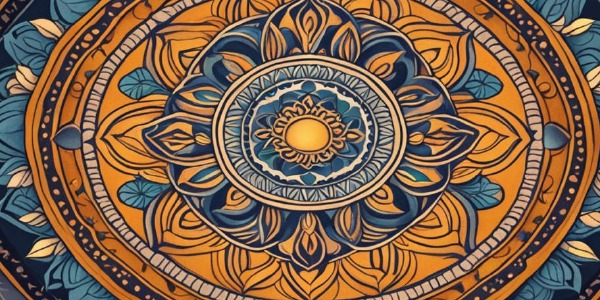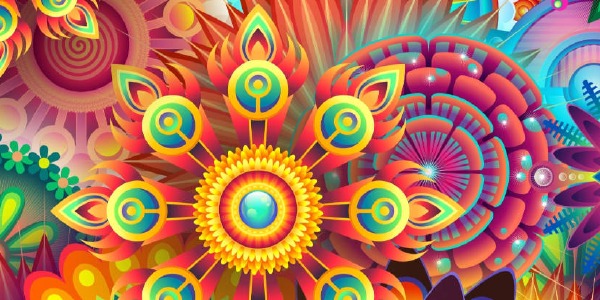Colors and Geometric Shapes in Mandalas: What do they represent?
Mandalas are sacred geometric patterns that hold deep symbolic meaning across various cultures and religions. Derived from the Sanskrit word for “circle,” Mandalas represent the universe, wholeness, and harmony. The intricate shapes, vibrant colors, and repetitive patterns found in Mandalas have specific meanings tied to spiritual and psychological realms. For example, circles represent unity and the eternal cycle of life, while triangles symbolize balance and divine energy. The colors used in Mandalas carry emotional and psychological significance, with each color representing different aspects of human experience.
Exploring the Meaning of Colors Used in Mandalas
The vast range of colors used in mandala designs adds depth and meaning to these intricate patterns. By understanding the meanings behind each color, one can gain a greater appreciation for the complexity and spiritual significance of the mandala.
Each color used in a Mandala carries specific symbolic meanings that contribute to its overall interpretation. Let’s explore the core significance of some common colors seen in Mandalas understand their psychology and unveil the emotional and psychological connotations:
Red: The Fiery Passion

Picturing a red Mandala might evoke feelings of excitement or intensity, tuning us in with our primal instincts.
It can signify a transformative energy, driving change and breaking down barriers.
Blue: Diving into the Zen

Blue signifies tranquility and calmness, much like the peacefulness of a serene blue ocean or clear sky. It could also symbolise wisdom and healing, represent spiritual strength and the ability to communicate truth. In Buddhist tradition, it represents eternity and purity.
A blue Mandala can help to encourage feelings of relaxation and support introspection.
In mandala designs, blue can be a symbol of peace and deep inner reflection, encouraging introspection and meditation.
Green: growth and balance, connected with nature

Green is the color of nature, growth, and rejuvenation. It stands for harmony, fertility, renewal or new beginnings. It can also represent the interconnectedness of life. In Hindu tradition it represents the heart chakra.
Incorporating green into a Mandala reinforces the sensations of harmony and stability, symbolizes health, abundance, and new beginnings..
Yellow A Ray of Optimism

It brings a sense of optimism and energy to mandalas and is often associated with clarity, enlightenment, and the ability to make wise decisions.
On the psychological plane, yellow may help stimulate intellectual growth and creativity. Spiritually, it symbolizes self-confidence, personal power, and playfulness.
White: the Color of Pure Potential

The color represents purity, innocence, peace, spiritual focus and awareness. In mandala designs, white is often used to symbolize mindfulness, truth, and the ability to detach from worldly concerns.
White color mandalas may look simple or even bare, but they represent wholeness. This color signifies the unbroken, the untarnished, and the infinite realm of possibilities.
In psychology, white is often associated with clarity, cleansing, and mental agility.
In Hindu and Buddhist cultures, it can also symbolize death or transition.
Black: Embrace the Mystique

The color black in mandalas signifies mystery and deep introspection. It can represent the need to confront our deepest fears and the potential for transforming dark thoughts into positive energy. Psychologically, black can promote restorative sleep and recovery.
Purple: Dwell in the Divine

Purple is a regal and spiritual color, often associated with the divine, spiritual insight, intuition and wisdom. It can signify the search for truth, inner understanding, and an awareness of the connection between the physical and spiritual
In mandalas, purple represents the universe, or higher realms of consciousness . On a psychological level, purple can inspire a sense of mental balance and help tap into our creative and imaginative resources.
Orange: Creativity and Transformation

Orange is an energetic and vibrant color, symbolizing enthusiasm, desire, and creativity. In mandalas, orange can represent transformation, overcoming obstacles, and the power of optimism.
Orange, rich with the energy of both red and yellow, brings charm, enthusiasm, and transformation to the discourse. Its vibrancy fosters creativity and stimulates emotional expressions in a mandala. As a signifier of transition, orange also symbolizes the changing seasons or significant life changes, encouraging acceptance and adaptability.
Gold: Wisdom and Enlightenment

Gold is a symbol of wealth, prosperity, and eternal light. It can represent spiritual abundance, wisdom, and the divine presence within all living beings. Gold captures the essence of wisdom beyond our ordinary understanding.
In a mandala gold is akin to light illuminating the darkness it’s also a beacon of wisdom and enlightenment.
Psychologically, *gold is associated with prosperity, achievement, and high ideals, helping to instill a sense of optimism and confidence.
Pink: Love and Compassion

Pink, the softer cousin of red, is a gentle color that represents unconditional love, compassion, nurturing and unconditional care. It promotes the feelings of warmth and tenderness.
In mandalas, pink can symbolize the importance of self-love and the ability to forgive and heal emotional wounds.
Psychologically, pink can evoke comfort and relieve feelings of anger or resentment.
Imagine the gentle energy of a pink mandala soothing your heart after a tough day!
Brown: Grounding and Stability

Brown, just like the earth beneath our feet, stands for grounding, stability, and reliability. This color reconnects us to the earth’s energy and the simpler things in life, offering a sense of calm and security.
In mandalas, brown can symbolize the need to balance the material and spiritual aspects of life.
Psychologically, brown encourages feelings of steadiness and resilience, helping us to stay rooted in reality.
The Science Behind Colors
All these emotional connotations of colors are not just aesthetic or spiritual considerations. They actually have a scientific basis.
According to studies, colors can significantly alter our mood and have significant influence on our reactions.
The Color Palette of Cultures
Although scientific research has investigated the emotional impact of colors, it’s crucial to acknowledge that interpretations of colors can vary greatly among cultures and historical contexts.
For instance, in Western cultures, white often represents purity or innocence, while in some Eastern cultures, it symbolizes mourning. Similarly, red may signify luck and happiness in some Asian cultures, while in the United States, it can symbolize passion or even aggression.
Understanding these cultural distinctions is vital when communicating with diverse audiences, as the emotional response to certain colors will likely depend on these cultural frameworks.
Mandalas, being a universal art form, embrace these cultural variances and often incorporate an amalgamation of color interpretations from around the world.
Exploring the Basic Geometric Shapes Used in Mandalas
The basic geometric shapes and forms used in creating Mandalas are circles, squares, and triangles, but the intricacies within these designs can become vast and complex.
Let’s delve into the meaning of these shapes.
Circles
Circles are one of the most potent shapes found in Mandalas. The circle represents the universe, eternity, and unity. It conveys the idea of whenever something ends; something new begins. Circles can both enclose and be enclosed by other elements, reflecting the cyclical nature of life.
Squares
Squares within Mandalas most commonly form a ‘quadrant’, which is divided into four squares within the larger Mandala. According to Hindu and Buddhist traditions, these squares symbolize stability and grounding. The four corners can further represent the four cardinal directions (north, south, east, and west), the four major elements (earth, air, fire, and water), or the four aspects of life (spiritual, mental, physical, and emotional).
Triangles
Triangles can have various meanings based on their orientation in Mandalas. Pointing upwards, they are usually associated with action, energy, and male aspects. When oriented downwards, they suggest receptivity, passivity, and female characteristics. Multiple triangles combined can form more complex structures like stars, further amplifying their symbolic power.



